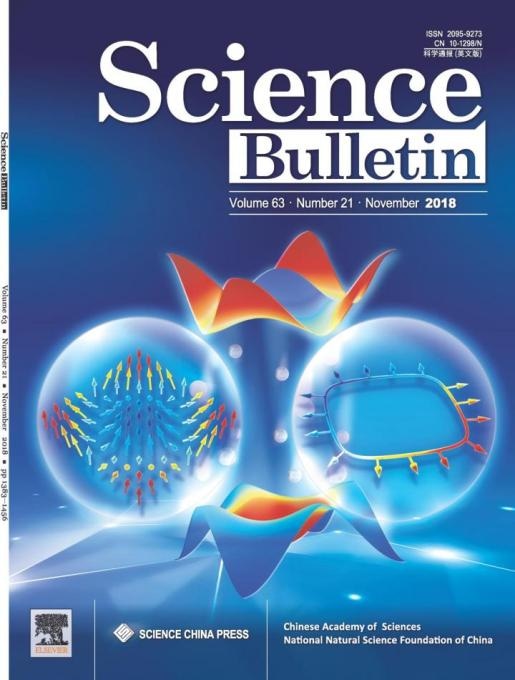Dec 24 2018
One of the most fundamental problems in the realm of topological quantum physics is how to characterize a topological phase. Traditionally, what characterizes a topological phase is a topological invariant defined for a many-particle ground state in equilibrium.
 This is the front cover of Science Bulletin 2018(21) issue. (Image credit: Science China Press)
This is the front cover of Science Bulletin 2018(21) issue. (Image credit: Science China Press)
There emerges a generic question: does there exist a non-equilibrium characterization of a topological phase defined in equilibrium? Recently, Xiong-Jun Liu’s team at Peking University addressed this non-trivial question. Liu introduced a non-equilibrium classification theory of equilibrium free-fermion topological phases using integer topological invariants and bridged non-equilibrium quantum dynamics and equilibrium topological phases. The study was published as a cover paper in the journal Science Bulletin on September 29th, 2018, (Cover Story: https://www.journals.elsevier.com/science-bulletin/cover-stories/dynamical-classification-of-topological-quantum-phases).
In the theory, which was created for the generic d-dimensional free-fermion topological phases, different phases were differentiated by different integer topological invariants such as the winding numbers or Chern numbers. It is possible to induce the non-equilibrium dynamics by quench, a process which involves suddenly tuning the system from an initial trivial phase to a final topological regime.
The researchers discovered that the behavior of the bare quench dynamics is random, whereas the time-averaged non-equilibrium dynamics demonstrate emergent nontrivial topological pattern in the lower (d-1)-dimensional hypersurfaces, known as band-inversion surfaces, of the Brillouin zone. An emergent topological pattern such as this distinctively corresponds to and hence characterizes the bulk topology of the equilibrium phase by means of an emerging dynamical topological invariant, presenting the generic non-equilibrium characterization theory of topological phases.
This theory acts as a link between the studies of topological phases and non-equilibrium quantum physics. On one hand, the study advances the topological phase characterization from equilibrium theory to non-equilibrium theory, and offers fundamentally new schemes for the detection of topological states beyond the equilibrium scenarios. The dynamical schemes demonstrate evident benefits over the traditional equilibrium schemes in the detection of topological states. On the other hand, the study helps to understand the characterization of complex non-equilibrium quantum dynamics by topology.
In the field of condensed matter physics, in general, it is highly complicated to characterize non-equilibrium quantum physics compared to the characterization of equilibrium phases. For instance, even after fixing the initial and final phases for the quench study, several paths are required to perform the quench, and the induced bare non-equilibrium quantum dynamics can be acutely different in various quench processes. Most notably, according to Liu et al.’s theory, all the apparently distinct quench dynamics manifest similar hidden universal behavior: they demonstrate the same emergent nontrivial topological pattern on the band inversion surfaces, and hence fall into the same topological class.
A new problem is that whereas the quench dynamics is linked to the equilibrium topological phase, the emergent topology of the quantum dynamics is by itself distinct from the traditional equilibrium topological phases. For future studies in this direction, there exist many intriguing open questions to be further addressed.
Specifically, similar to an equilibrium topological phase in which there exist various nontrivial physics that can be acquired, for example, the topologically protected gapless boundary modes and defect modes, as well as the topological stability against local perturbations, and so on, does similar nontrivial topological physics exist in the emergent topological states of the quench dynamics? Moreover, is there a possibility for the emergent topological states to occur in the correlated systems? All these questions are new and warrant future studies.